Recent Articles
Popular Makes
Body Types
2017 Ford Mustang GT vs. 2017 Dodge Challenger R/T: Which is Best?
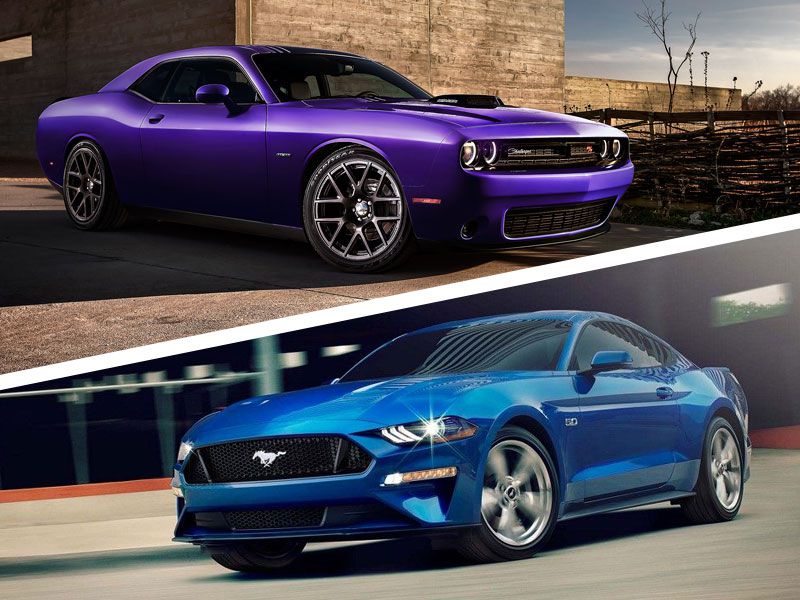
Dodge Challenger vs Ford Mustang ・ Photo by Dodge / Ford
The 2017 Ford Mustang GT and 2017 Dodger Challenger R/T mark the point where pony cars become muscle cars. Unlike their respective base versions, these trims provide V8 engines under the hood, which is how things really ought to be. This is America, after all. These two are natural rivals while also offering their own specific charms. The Mustang is one of the most recognizable American cars around the world, and this current generation is still relatively fresh. It’s the most refined Mustang ever. The Challenger is more of an aficionado’s choice, a little hipper because it’s not as ubiquitous. This comparison feature focuses on the coupe versions (or Fastback, in Mustang-speak) since there isn’t a convertible Challenger variant.
Pricing and Trim Levels
The 2017 Ford Mustang GT starts at $34,095, which includes 18-inch alloy wheels, keyless entry/ignition, and an 8-inch infotainment screen. The Premium trim, from $38,095, brings leather-covered Recaro sport seats plus ambient cabin lighting and a few more extras. The 2017 Dodge Challenger R/T starts at $34,090. Like the Mustang, it’s quite generously equipped. Standard kit includes 20-inch alloy wheels, keyless entry/ignition, a performance suspension (one sporty step up from regular) and a 5-inch infotainment screen. No aspect of either car is a particular deal-breaker or deal-maker in this context. So we’ll have to call it a tie.
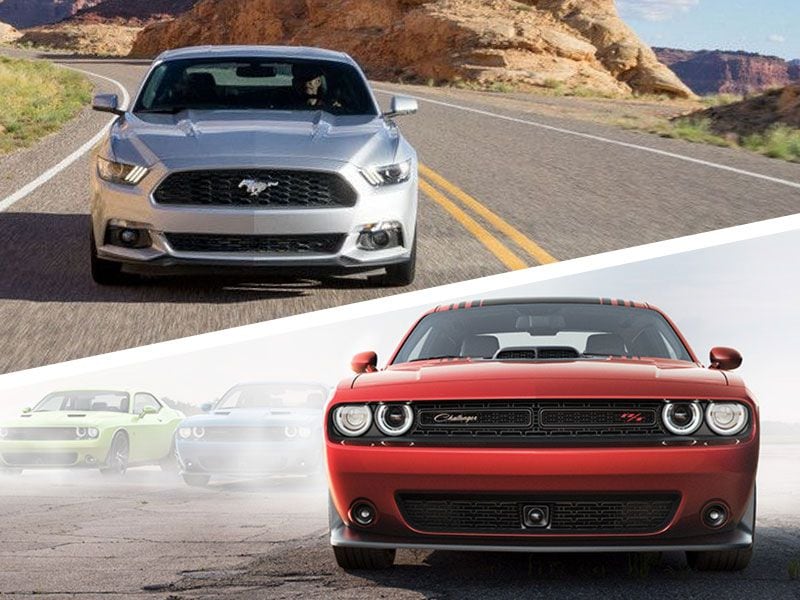
Photo by Dodge / Ford
Options
Mustang buyers may choose from several limited-slip differentials and alloy wheel designs. Also on the menu are rear parking sensors, adaptive cruise control with forward collision mitigation, and blind-spot monitoring with rear cross-traffic alert. The Challenger R/T is eligible for a “Super Track Pack” with paddle shifters for its automatic transmission, high-performance tires, rear spoiler and selectable engine/transmission modes. A Driver Convenience bundle includes rear parking sensors, blind-spot monitoring with rear cross traffic detection and power-folding mirrors. A sunroof is available, along with an infotainment system upgrade for an 8.4-inch touchscreen, satellite radio and navigation. The Dodge’s options don’t seem as sophisticated as the Ford’s, so the Mustang takes this round.
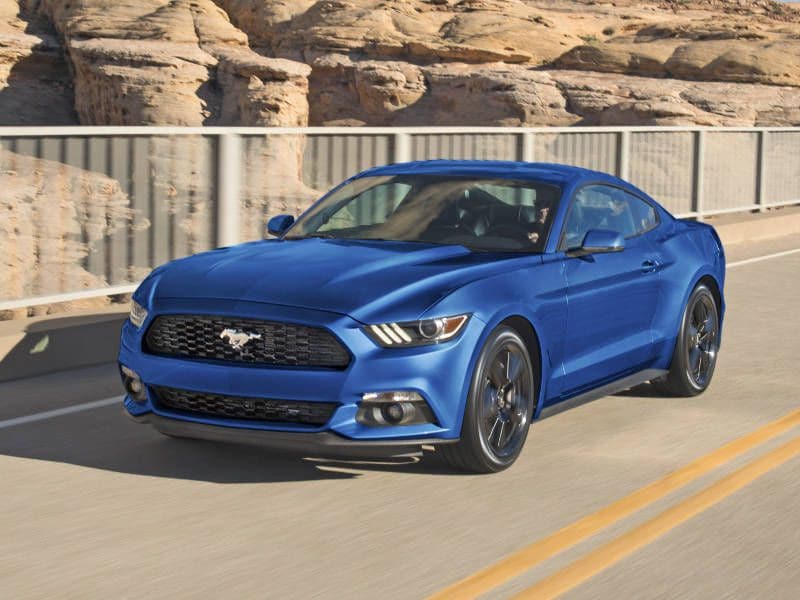
Photo by Ford
Powertrains
The Mustang GT packs a 5.0-liter V8 with variable valve timing. It develops 435 hp and 400 lb-ft of torque. The Challenger R/T has a 5.7-liter V8 making 375 hp and 410 lb-ft of torque when paired with the six-speed manual transmission, or 372 hp and 400 lb-ft with the optional eight-speed automatic transmission. Despite only offering a six-speed automatic, the Mustang has the most horses and only comes up short in the torque department by 10 lb-ft, thereby winning this section.
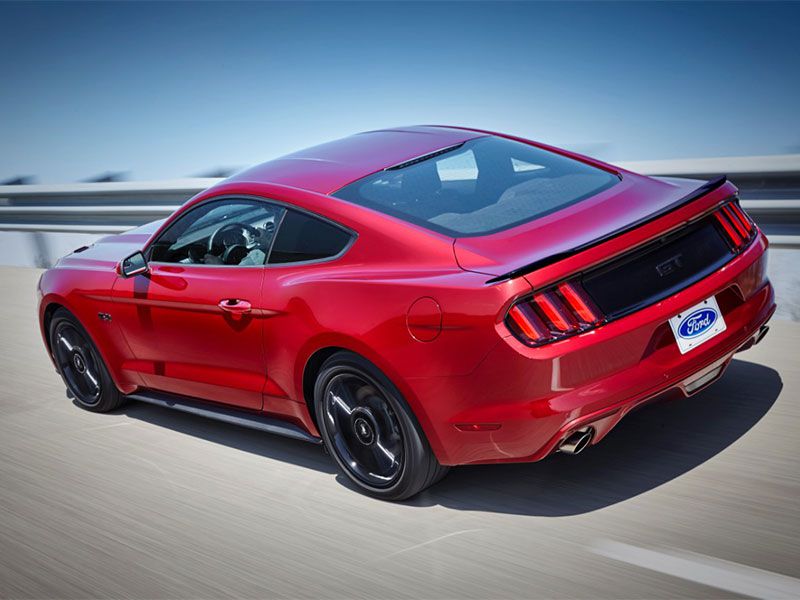
Photo by Ford
Fuel Consumption
With the standard six-speed manual transmission, fuel consumption for the Mustang GT is estimated at 15 mpg city, 25 mpg highway and 18 mpg combined. The six-speed automatic adjusts those figures to 15/24/18 mpg. The Challenger’s fuel consumption is 15/23/18 mpg (manual) or 16/25/19 mpg (automatic). In the real world, it’s doubtful the drivers of either car would notice or care that much about saving a mile per gallon here or there. Nevertheless, we have to go by the numbers and we’re impressed by Dodge offering an eight-speed automatic transmission, so the Challenger takes this category.
Challenger
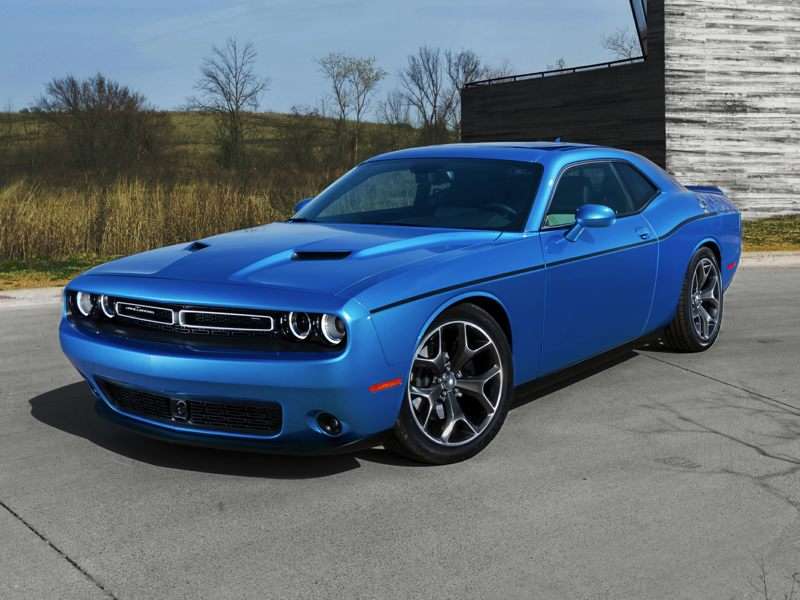
Photo by Dodge
Standout Features and Technology
These are primarily enthusiast cars. Although they both have conveniences like Bluetooth and dual-zone automatic climate control, these aren’t the real attractions. The Mustang GT sports a mechanical limited-slip rear differential to more fully exploit the rear-wheel drive setup. It also has an “electronic line lock” to warm the rear tires (in the real world: perform burn-outs), and the manual transmission version comes with launch control. The Challenger R/T gets a relatively wide 2.75-inch exhaust for a suitably raucous soundtrack. It also has upgraded brakes. The Dodge’s Uconnect infotainment system is well liked for its user-friendliness. There’s more of a learning curve with the Ford’s Sync 3 system, but this round belongs to the Mustang.
Mustang
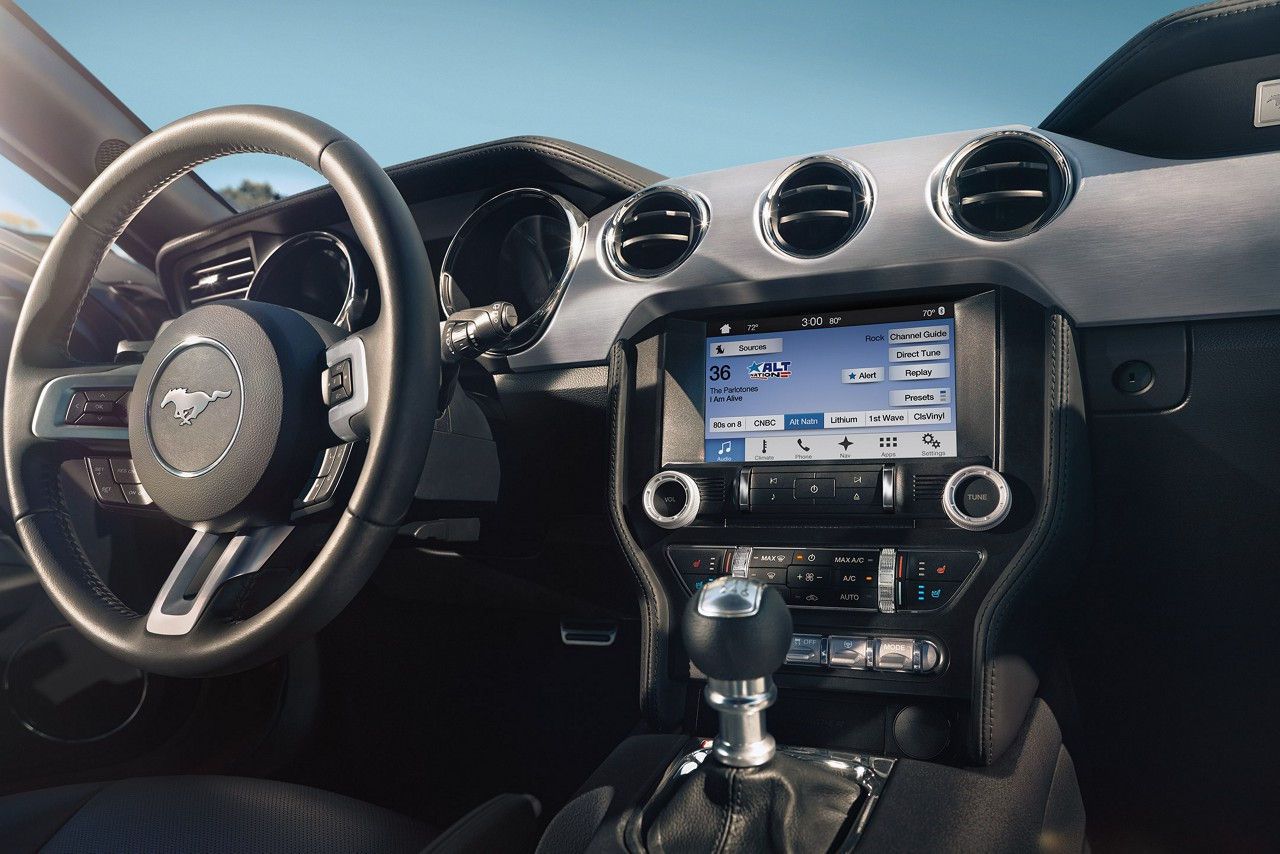
Photo by Ford
Exterior Design
Over its many generations, the Mustang’s styling has veered between awesome and awful. Right now, it seems like a transitionary phase, wanting to acknowledge some of the cool features that have come before, yet also trying to be forward-looking and even attempting some kind of family resemblance with other Ford cars. Retro is where the Challenger lives. Its design hasn’t changed much since it came out in 2008, and even then there was a 1970s vibe to it. In a way, this is an advantage because it doesn’t look like it’s trying too hard; it suits the Challenger’s cool, outsider character. There’s no way this section could be anything other than a tie.
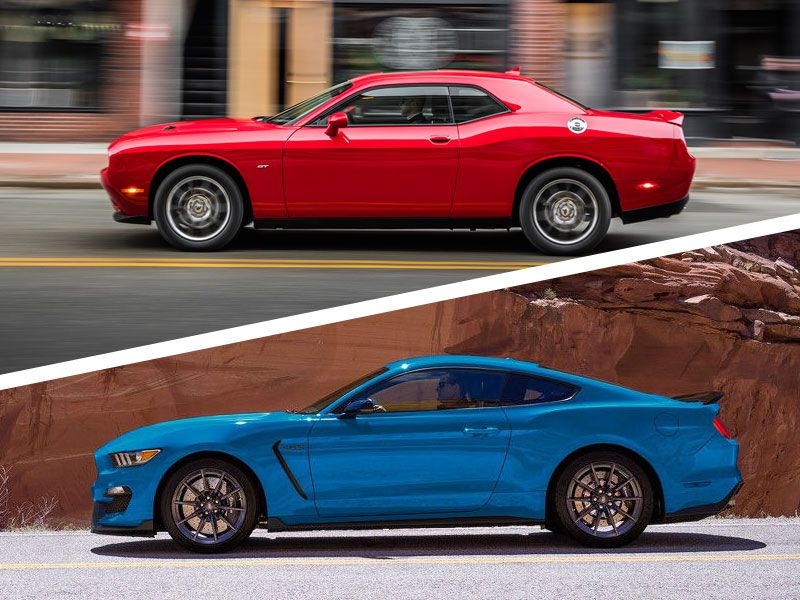
Photo by Dodge / Ford
Interior Design
It might be argued that the aluminum section going across the top of the Mustang’s dashboard is overdone, while everything else — with the exception of the retro-styled steering wheel — is a bit underdone. The quality of materials is definitely a step up from previous Mustangs, though. The Challenger’s dashboard is more driver-centric while continuing the exterior’s backward-looking flavor. The plastics also tend to be evocative of past times when things weren’t quite as classy as they are now. Luckily, a rearview camera is standard, because the large rear pillars tend to make outward vision tricky on occasion. The Mustang wins this round by a whisker.
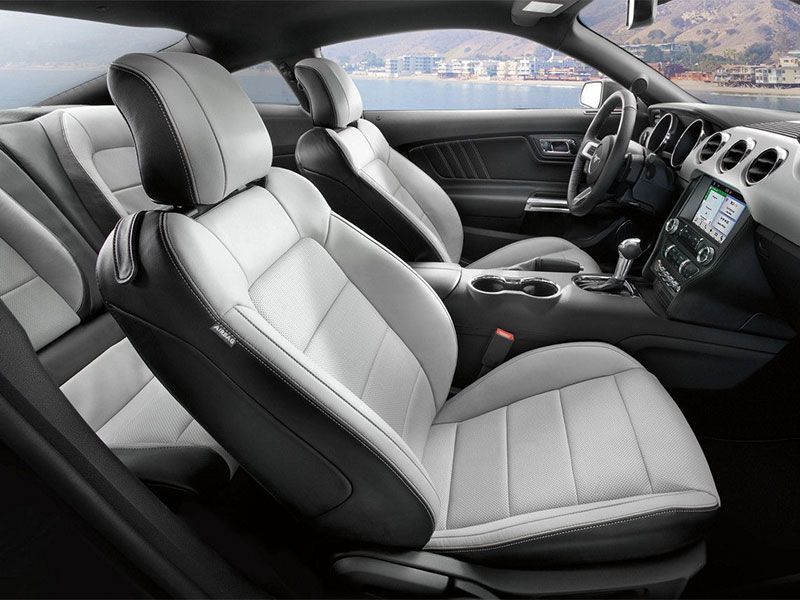
Photo by Ford
Comfort
Within the Mustang’s 82.8 cubic feet of occupant space is seating for four and 29 inches of rear legroom. It’s cozy. The Challenger is more spacious, with 93.9 cubic feet of interior volume and 33.1 inches of rear legroom, plus a third seating space set into the back row. This is a wide car. The Challenger’s fundamental suspension includes some Mercedes-Benz parts, contributing to the general comfort. R/T stands for Road/Track, incidentally. Not that the Challenger’s ride is particularly firm. In fact, this would be the road trip choice for long highway drives — whereas the Mustang shines brighter in corners. Since this category is called “Comfort,” we’re giving it to the Challenger.
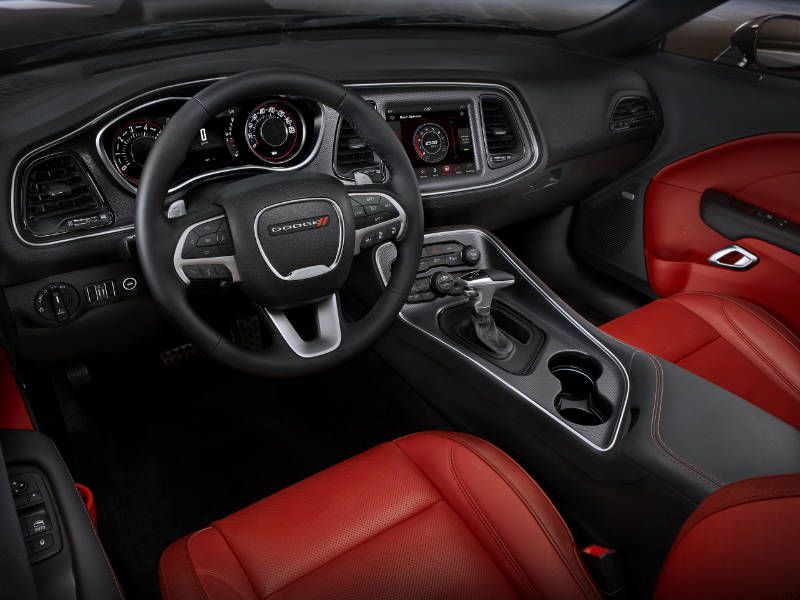
Photo by Dodge
Cargo Capacity
It’s not like these are family cars and their trunks have to swallow a week’s worth of grocery shopping. Even so, the Mustang’s trunk measures a handy 13.5 cubic feet. That’s in line with a decent compact car and good enough for three sets of golf clubs. The rear seat is split-folding. The Challenger’s rear seat folds in a 60/40 split while trunk space is 16.2 cubic feet, which would be big even for a mid-size sedan. We could imagine a rock guitarist turning up to gigs in a Challenger with a Marshall half stack stashed in the trunk. For being cool and commodious at the same time, this section goes to the Challenger.
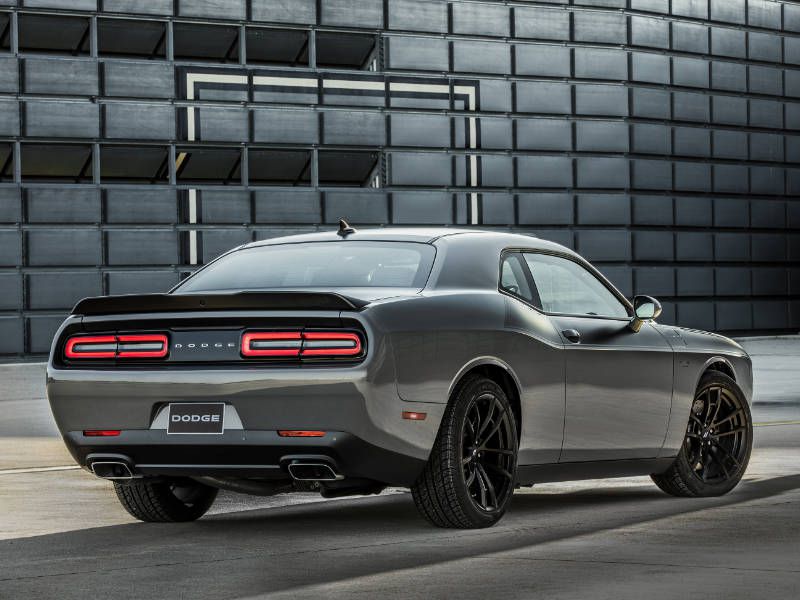
Photo by Dodge
Safety Ratings
The Mustang has a knee airbag for the drive and scores a maximum five stars from the National Highway Traffic Safety Administration. It hasn’t been fully tested by the Insurance Institute for Highway Safety but took the top score of Good for moderate front overlap and side impact protection, plus Good for seats and head restraints. The Challenger also earns five stars overall from the feds, plus Good scores from the IIHS for moderate front overlap and side impacts. But its driver’s-side small front overlap performance was deemed Marginal, while seats and head restraints were marked only as Acceptable. Both cars have disc brakes at each end and rearview cameras as standard. But it’s a category win for the Mustang.
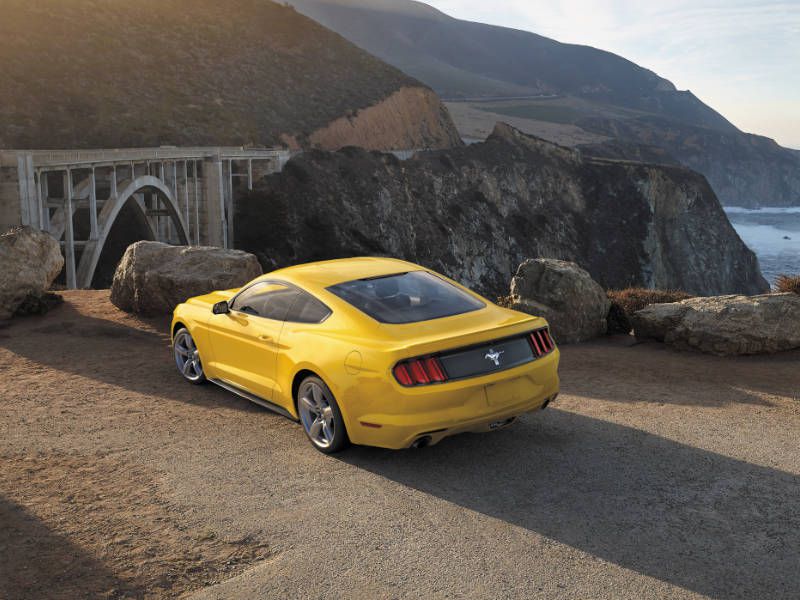
Photo by Ford